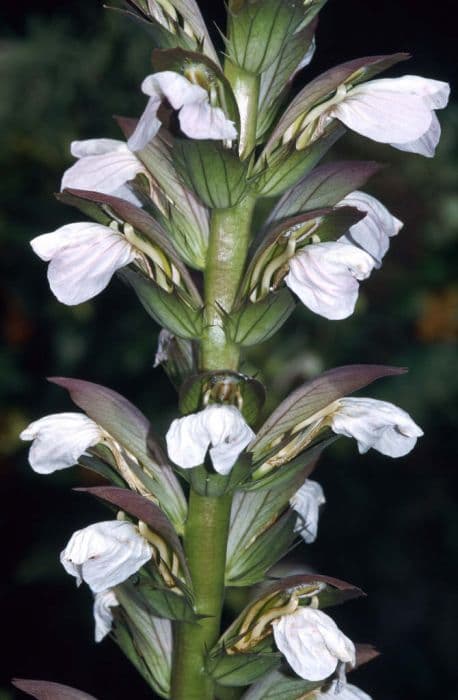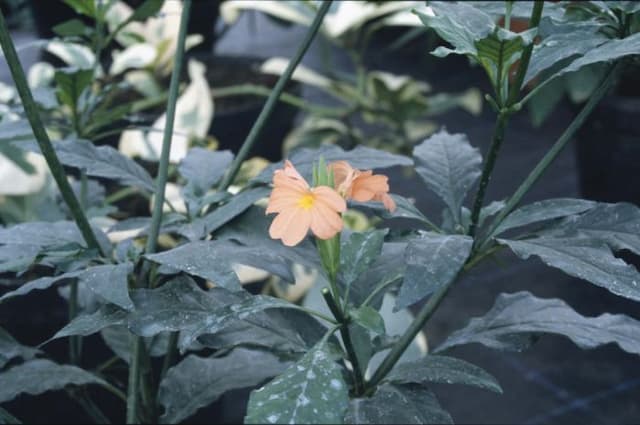Zebra Plant Aphelandra squarrosa 'Louisae'

ABOUT
The Aphelandra squarrosa 'Louisae', more commonly known as the zebra plant, is a striking houseplant known for its decorative foliage and bright flowering bracts. The leaves of the zebra plant are glossy and dark green, featuring prominent white veins that create a zebra-stripe effect, which is where the plant gets its common name. The texture of the leaves is somewhat leathery to the touch, with a slightly wavy edge that adds to their ornamental appeal. In contrast to its lush foliage, the zebra plant produces vibrant yellow flower bracts that emerge from the top of the plant. These bracts are actually modified leaves that surround the plant's small, true flowers. The flowering bracts are typically long-lasting and add a bright pop of color to the plant's display. Overall, the zebra plant exudes a tropical vibe with its lush, patterned foliage and eye-catching blooms. It is favored by enthusiasts both for its unique appearance and for the touch of exotic flair it can add to a plant collection or interior space.
About this plant
 Names
NamesFamily
Acanthaceae.
Synonyms
Zebra Plant, Saffron Spike.
Common names
Aphelandra squarrosa 'Louisae'.
 Toxicity
ToxicityTo humans
The Aphelandra squarrosa, commonly known as the Zebra Plant, is not considered highly toxic to humans. Generally, ingestion of parts of the plant may cause mild discomfort such as stomach ache, vomiting, or diarrhea. It's important to keep the plant out of reach of small children who may be tempted to chew on its leaves, as the plant can cause irritation of the mouth and throat.
To pets
The Zebra Plant can be mildly toxic to pets if ingested. Symptoms of poisoning in pets may include vomiting, diarrhea, and possible drooling if the leaves are chewed, due to the irritation of the mouth and stomach. While it's not likely to be life-threatening, it can cause discomfort to your pet, and veterinary assistance should be sought if symptoms persist or are severe.
 Characteristics
CharacteristicsLife cycle
Perennials
Foliage type
Evergreen
Color of leaves
Variegated
Flower color
Yellow
Height
1-2 feet (30-60 cm)
Spread
1 foot (30 cm)
Plant type
Shrub
Hardiness zones
10
Native area
Brazil
Benefits
 General Benefits
General Benefits- Decorative Appeal: Aphelandra squarrosa 'Louisae', commonly known as Zebra plant, offers ornamental value with its striking green and white striped foliage and vibrant yellow inflorescence.
- Habitat Enrichment: This tropical plant can contribute to a diverse indoor ecosystem, providing shelter and comfort for small fauna when kept indoors.
- Humidity Enhancement: Zebra plants can increase local humidity through their natural transpiration process, which may benefit other nearby plants that thrive in more humid conditions.
- Mood Improvement: The presence of plants like the Zebra plant in indoor spaces has been shown to improve mood and reduce stress levels in humans, likely through aesthetic enjoyment and a subconscious connection to nature.
- Visual Structure: With its bold foliage, the Zebra plant can add structure and a focal point to indoor garden arrangements or plant collections.
- Learning Opportunity: Growing a Zebra plant can serve as an educational experience, teaching about plant care, tropical ecosystems, and botany.
- Cultural Significance: In some cultures, plants like Aphelandra squarrosa 'Louisae' are used in traditional decorative arts, adding a layer of cultural heritage to its cultivation.
 Medical Properties
Medical PropertiesThis plant is not used for medical purposes.
 Air-purifying Qualities
Air-purifying QualitiesThis plant is not specifically known for air purifying qualities.
 Other Uses
Other Uses- The Zebra Plant can be used as a living art piece by creating a patterned display with its striking foliage when placed on wall-mounted shelves or in vertical gardens.
- As a subject for botanical illustration, the Zebra Plant's unique appearance provides a distinct challenge for artists looking to capture the intricate patterns of nature.
- In educational environments, the Zebra Plant is useful in teaching about plant care and tropical ecosystems due to its specific growing requirements.
- The leaves of the Zebra Plant can be used in flower arrangements for a touch of greenery that adds texture and visual interest to the composition.
- For hobbyist photographers, the plant's contrasting leaf patterns present an excellent opportunity to practice macro and close-up photography skills.
- As a tool in mindfulness and meditation practices, observing the growth and changes in the Zebra Plant can be a calming activity that encourages patience and attentiveness.
- In themed events like jungle or tropical parties, the Zebra Plant serves as an authentic decoration to help set the mood and enhance the ambiance.
- The Zebra Plant can be used as a natural indicator of humidity levels, requiring high humidity to thrive and indicating when air in its environment is too dry.
- Zebra Plants can be presented as eco-friendly gifts to those interested in sustainability, adding greenery to their space without the need for synthetic materials.
- For craft enthusiasts, the distinctive leaves of the Zebra Plant can be used as templates or inspiration for creating patterns on textiles, such as stamping or stencil work.
Interesting Facts
 Feng Shui
Feng ShuiThe Zebra Plant is not used in Feng Shui practice.
 Zodiac Sign Compitability
Zodiac Sign CompitabilityThe Zebra Plant is not used in astrology practice.
 Plant Symbolism
Plant Symbolism- Uniqueness - The distinct zebra-patterned foliage of the Zebra Plant, the common name for Aphelandra squarrosa 'Louisae', symbolizes uniqueness due to its standout stripes, which are not commonly seen in other houseplants.
- Exotic Beauty - With its bright yellow flowers and ornamental leaves, the Zebra Plant signifies exotic beauty, suggesting a sense of fascination and allure that is often associated with the exotic and unknown.
- Pride - The upright growth and bold patterns of the Zebra Plant could symbolize pride, representing confidence and self-assurance in one's unique traits.
- Rarity - Due to its unique appearance, the Zebra Plant is often seen as a symbol of rarity, celebrating the unusual and less common aspects of nature.
 Water
WaterThe Zebra Plant prefers consistent moisture and should be watered when the top inch of soil feels dry to the touch. Water it thoroughly until excess water drains out of the bottom of the pot, which should be roughly every week, but frequency can vary depending on environmental conditions like temperature and humidity. Use lukewarm water and avoid water sitting in the saucer, as this can lead to root rot. During the growing season in spring and summer, the Zebra Plant may need more frequent waterings, sometimes twice a week, while in the dormant winter season, reduce watering to every couple of weeks. It is estimated that for an average-sized pot, you may use about 8-16 ounces of water per week during the active growth phase.
 Light
LightThe Zebra Plant thrives in bright, indirect light but can tolerate short periods of direct sunlight, preferably morning light. The best spot for the plant would be near an east- or north-facing window where it receives plenty of light without the harsh midday sun. Avoid placing it in full, direct afternoon sunlight as this can scorch the leaves.
 Temperature
TemperatureThe Zebra Plant does best in an environment where temperatures are consistently between 65°F and 75°F. It can survive in temperatures as low as 55°F but not lower, as cold drafts and sudden temperature fluctuations can damage the plant. It's important to keep the Zebra Plant away from vents and exterior doors to prevent exposure to extreme cold or heat.
 Pruning
PruningPruning the Zebra Plant is crucial for maintaining its shape, encouraging bushier growth, and removing any yellowed or damaged leaves. The best time for pruning is in the spring or after the flowering period has ended. Prune the Zebra Plant by cutting back leggy stems and shaping the plant as desired, using clean and sharp tools. This can be done annually or biannually as needed to keep the plant looking its best.
 Cleaning
CleaningAs needed
 Soil
SoilZebra plant thrives best in a well-draining, rich potting mix, often a blend of peat, pine bark, and perlite or sand. A pH between 6.0 and 6.5 is ideal for this tropical species.
 Repotting
RepottingZebra plants should ideally be repotted every 12-18 months to replenish the soil and accommodate their growth. Do this preferably in the spring.
 Humidity & Misting
Humidity & MistingZebra plants require high humidity, ideally between 60% and 70% to mimic their native tropical environment.
 Suitable locations
Suitable locationsIndoor
Place Zebra plant in bright, indirect light and maintain high humidity.
Outdoor
Grow Zebra plant in shade with shelter from wind and scorching sun.
Hardiness zone
11-12 USDA
 Life cycle
Life cycleAphelandra squarrosa 'Louisae', commonly known as the Zebra plant, begins its life cycle as a seed, which germinates in warm, moist soil, usually in the spring or early summer. After germination, the seedling emerges and transitions into the vegetative growth stage, developing characteristic dark green leaves with white veins. As the Zebra plant matures, it enters the flowering stage, typically in late summer or autumn, producing yellow or orange bracts from which small flowers bloom. After pollination, if occurs, seeds develop and are dispersed, completing the reproductive cycle. In the absence of pollination, the plant may continue to grow vegetatively, potentially being propagated by cuttings to produce new plants. The life span of the Zebra plant can last several years, though it may require repotting and pruning to manage growth and encourage blooming in subsequent seasons.
 Propogation
PropogationPropogation time
Spring-Early Summer
The Aphelandra squarrosa 'Louisae', commonly known as the Zebra Plant, is best propagated through stem cuttings. This method is most successful in the spring and early summer when the plant is in its active growth phase. To propagate by stem cuttings, select a healthy stem with at least two leaf nodes. Cut the stem to about 4 inches (10 centimeters) in length and remove the lower leaves to expose the nodes. Dip the cutting's end in a rooting hormone to enhance root development. Then, plant the cutting in a moist potting mix, positioning it so that the exposed nodes are buried. Place the pot in a warm area with bright, indirect light and maintain the soil moisture. Roots should begin to form within several weeks, after which the new Zebra Plant can be gradually acclimatized to normal growing conditions.









